MARTIN DOUVEN LEOPOLDSBURG JEF GEYS - M HKA
MARTIN DOUVEN LEOPOLDSBURG JEF GEYS - M HKA
MARTIN DOUVEN LEOPOLDSBURG JEF GEYS - M HKA
You also want an ePaper? Increase the reach of your titles
YUMPU automatically turns print PDFs into web optimized ePapers that Google loves.
<strong>MARTIN</strong> <strong>DOUVEN</strong><br />
<strong>LEOPOLDSBURG</strong><br />
<strong>JEF</strong> <strong>GEYS</strong><br />
09.09 > 31.12.11
2<br />
INDEx<br />
EXHIBITION 03<br />
(texts by Griet Wynants / Joris Note)<br />
PuBlIcaTION / mulTIPlE / cOlOurING BOOk / 3D-PrINT) 06<br />
THE EXHIBITION vIsually 15<br />
vIsuals 19<br />
THE arTIsT 22<br />
alsO IN THE m Hka 23<br />
m Hka EXPEcTs 25<br />
m Hka PracTIcal 26<br />
m Hka ParTNErs 27
3<br />
1.<br />
ExhIBITION<br />
TExT BY GRIET WYNANTS<br />
The activities of martin Douven (1898-1973), a self-taught artist from<br />
leopoldsburg, provide the starting point of the exhibition.<br />
Douven began selling his own paintings as a young man in 1928 in furniture<br />
shops. as soon has his nine children were old enough, he got them painting<br />
also. according to the method of the “painter’s chain” each child took care<br />
of a part of the canvas (blue sky, cloud, tree...), and the father would<br />
finish it off. later he would train young employees from the neighbourhood<br />
in the technique of production-line painting. after the second World War his<br />
business grew to be a painting factory and a frame factory, because besides<br />
‘golden fingers’ Douven had developed a shrewd business sense: he realised<br />
all too well that there was a lot more money to be made from the canvases<br />
if he could deliver them framed. From the mid 1950s onwards the painting<br />
was only carried out by home-painters, who delivered more than 5000 works<br />
a week with all manner of subjects (floral pieces, landscapes, sea views,<br />
portraits...). an american journalist called martin Douven ‘the Henry Ford<br />
of oil painting’.<br />
apart from the frames the factory took care of worldwide distribution,<br />
and in time framed photographs and reproductions also became part of the<br />
line. During the 1960s the firm had 200 employees and a sister firm in aachen.<br />
In the early 1970s, because of a need for capital, an american industrial<br />
partner was courted: Intercraft Industries corporation took over the<br />
Douven company completely in 1975 and ended all activity in 1977. The lucasshops<br />
that sell all manner of drawing and painting materials are a remnant<br />
of Douven’s company.<br />
(Source: Gert Douven)
4<br />
In the 1950s the family Douven went to live in Leopoldsburg along the Kopslaan, whereas<br />
the young Jef Geys was living in the nearby Faytlaan. Jef Geys and François Douven were<br />
born in the same year and were at school together at the Brothers of Love. When Jef would<br />
visit his friend’s house, he witnessed the factory nearby in full productivity.<br />
Jef Geys says that he had to defend his own reputation as a ‘drawer’ in the first school<br />
year by drawing an African and a palm tree. Later he did a variation on this theme by drawing<br />
a scene of the comic strip characters Robbedoes and Piet Kwabbernoot who are sitting in a<br />
giant cauldron under the watchful eye of a few fellow black brothers, under the pseudonym of<br />
‘Mister x’.<br />
It was the free and easy time just after the war. Çois became part of his ingenious<br />
father Martin’s family team – and Jef mourned his first unhappy love story, with Monique C.,<br />
to whom he had attempted to explain on a cold winter’s day that he had nothing to offer her.<br />
In those days Leopoldsburg was famed for its internationally oriented mercantile spirit. In<br />
addition to 10.000 inhabitants there were about 100.000 soldiers stationed there during their<br />
encampment days; and then there were the wagon loads of adventurers who came to ‘assist’<br />
the ‘Camp’ population in their attempts to earn a few pennies extra during those glittering,<br />
cosmopolitan days. While father Douven was running his global company, father Geys, after<br />
an imposed adventure at eighteen in the First World War, and after a military career, had<br />
ended up as a ‘guard’ in Beringen at the mine.<br />
Jef did not succeed in getting into cadet school, but did spend four long years as a<br />
professional volunteer with the air force and then returned empty-handed to Leopoldsburg.<br />
his parents, his brother (who had helped occupy Germany with the Piron Brigade) and his<br />
youngest sister continued to support him.<br />
Jef Geys then decided to fulfil his greatest dream and decided to enrol in the Academy<br />
of Antwerp. he ended up in Piet Serneels’ class and at night followed the art history lessons of<br />
Professor Van der Brempt. In Serneels’ class for the first few days he sat beside Wannes van de<br />
Velde, who greeted him as a new-comer by passing him a drawing of a stylised coffee pot, with<br />
the words: ‘Take good care of that, I’m going to be famous!’<br />
Jef sees his dream take shape thanks to teachers like Serneels, Maclot, Dolphyn and<br />
Strebelle, but certainly also thanks to the paternal guards in a bluish policeman’s uniform<br />
and the open door policy of the fabulous library. In the morning he takes the earliest train to<br />
Antwerp and returns home with the latest one, until he can rent a two-roomed house in the<br />
Vlaaikensgang for 40 francs a month. The evening classes in French literature and Strebelle’s<br />
silver Porsche ‘décapotable’ provide the spice that keep him going.<br />
Serneels and inspector Van Looy make it possible for Jef to work for the company Signa<br />
Expo ’58: he has to stick the press pavilion full of cork letters and hands that indicate directions.<br />
New horizons open for him when in the United States pavilion he becomes acquainted<br />
with both ice cream and Saul Steinberg for the first time.<br />
After the academy days are over he goes with his friend Jef Van Dijck (who came from<br />
Studio herman Teirlinck) to the recently founded department of visual arts in the state school<br />
of hasselt: they have to obtain a diploma there if they are to be allowed to work in the state<br />
schools. At the end of the study Jef Geys – in part thanks to the intervention of the principal<br />
Corijn – is able to start work as a teacher in Sint-Lambrechts-Woluwe. he starts to undergo a<br />
whole series of mutations that ends at the state middle school of Balen; here he would stay for<br />
many years. After a series of fusions with a school in Mol and a disagreement with the new<br />
principal, he goes into a sort of early retirement. From the manner in which Jef speaks about<br />
his period in Balen you can tell that this was a ‘great time’ for him and his students.<br />
Balen is his wife Mia’s hometown, whom he met in 1958. Mia’s father, son of a cattle<br />
trader, was sent to the Saint Victor School in Turnhout before the Second World War, for his<br />
intellectual education, only to follow in his father’s footsteps. Fik Dammen – a calm, goodlooking,<br />
clever man – can live with the fact that his daughter has a boyfriend who is a somewhat<br />
older ex-academy student who is going to teach.<br />
And now there is a new connection with Martin Douven. Father Dammen, who meets<br />
his companions, on a professional basis in the café The Colourful Ox, deals in cattle but also
5<br />
does deals on the side in all manner of curiosities: a Greek temple with a built-in radio, a vase<br />
from 1900 with stuccoed animals on it of which one has lost its head, and... a painting, without<br />
a frame, with a romantic little lake and two swans. That painting is from Douven’s workshop.<br />
Jef was wrestling then, just as he still does now, with one question: what is real and<br />
what is pseudo real and what is abstraction? he attempts to find the strong lines in paintings,<br />
as taught to him at the Academy for the old masters, to identify the most important attributes.<br />
What makes an image ‘attractive’ and for whom, and how? Why does an image ‘work’? And<br />
so, in 1959, thanks to Fik Dammen, the ‘black painting with swans’ came to be, the first in a<br />
long range of black paintings on which Jef marks the key points geometrically (circle, triangle...).<br />
It is also the start of research into (see the ‘hundred model paintings’) painting itself:<br />
ground, material, subject, examples, followers, helpers, schools, signature... The history of the<br />
family Douven is the leitmotif in this research.<br />
And finally, Jef Geys not only confronts himself with Douven. he also find all kinds of<br />
parallels between his business and large studios like that of Rubens, where group work was<br />
still the order of the day.
6<br />
2.<br />
<strong>JEF</strong> <strong>GEYS</strong><br />
OR SOMEBODY ELSE<br />
TExT BY JORIS NOTE, SUMMER 2010<br />
FOrEPlay, Far aWay FrOm HOmE<br />
In 1955 a friendly polemic took place between the poet-politician from Martinique,<br />
Aimé Césaire (1913–2008) and the younger haitian poet René Depestre (1926). Both were<br />
Communists at the time, but it did not show in Césaire’s work; his poetic revolt tended far<br />
more towards Surrealism.<br />
Louis Aragon, a former Surrealist and by then a Communist Party bigwig, had elaborated<br />
in a series of articles which direction, according to him, ‘national poetry’ needed to take.<br />
he was of the opinion that classical ‘French’ forms should be wielded, whereas ‘individualistic’<br />
free verse was to be frowned upon. Depestre had devotedly adopted this view, although he did<br />
however wish to allow his African roots to play some part. In the periodical Présence Africaine<br />
Césaire retorted with an angry poem and an equally angry piece of prose. Depestre made a<br />
riposte in turn, and other black authors also mingled in the debate.<br />
It is possible that both texts by Césaire have something else to teach us, despite the fact<br />
that he vitalistically calls upon his African ‘blood’. his poem ‘Réponse à Depestre poète haïtien’<br />
reminds the young poet of the thunderbolt revolution out of which his country was born,<br />
and encourages him to lay down his servility to Western standards.<br />
Depestre I indict the bad manners of our blood<br />
is it our fault<br />
if the squall hits<br />
suddenly unteaching us to count on our fingers<br />
to circle three times and bow<br />
Metrical feet are among those things you can count on your fingers. Césaire mocks the return<br />
to bound verses and associates the polished sonnets with the sweet juice that is mechanically<br />
‘salivated’ by the sugar factories in the Caribbean. he also compares the old forms to beetles<br />
that eat up the young shoots in spring. Come on, comrade Depestre, let us both flee the faultfinders,<br />
‘just as we used to flee our masters with their whips’:<br />
marronnons-les Depestre marronnons-les<br />
Comme jadis nous marronnions nos maîtres à fouet<br />
The neologism ‘marronner’ is derived from marron, a runaway slave. Marrons lived in unbridled<br />
freedom and sometimes organised themselves in gangs that attacked the plantations.<br />
With Césaire the term is about dissidence, and a cheerfully detached attitude (‘rions buvons et<br />
marronnons’). We recognise no master, we have our own say.<br />
In the second text Césaire accuses Depestre of formalism (in sticking to previously
7<br />
established forms) and of ‘assimilationism’ (adaptation to, imitation of, the West), and he says<br />
poetry’s domain is rooted in the ‘authentic’, the personal experience. The latter is somewhat<br />
romantic, but it does not indicate mere spontaneous outbursts of moods. (Césaire was someone<br />
who worked and reworked his verses at length.) At the conclusion of his plea he states that<br />
the poets from the periphery are great enough to go their own way, and that their work can<br />
only exist if they maintain their ‘right to initiative’.<br />
Does the preceding have anything at all to do with Jef Geys? Barely. Or does it?<br />
Wasn’t it Geys who suddenly untaught us (Kleurboek voor volwassenen, 1963–1965,<br />
‘Colouring Book for Adults’) that Great Britain and Vietnam are not neighbours on the map?<br />
Isn’t all his work also about the right to initiative of whomever? Doesn’t he frequently lead<br />
us to understand that the universal can only be attained by means of the individual characteristic<br />
and the local? Isn’t authenticity also something that is essential to him? Doesn’t<br />
Césaire’s critique of factory-like sonnets remind us of Geys’s fascination with assembly lines<br />
and routine – and of his distrust towards forms, artistic, polished and other? Can Geys’s tense<br />
relationship vis à vis the official art circuit (and society) not be seen as a kind of marronnage?<br />
The identification with the marron has something compelling about it; it is intoxicating,<br />
but, for precisely that reason, it is also somewhat dubious. With some later, less exalted<br />
Antillean authors, that valiant figure had to make way for the djobeurs, those insignificant personages<br />
who do not stand opposite the social order but find themselves in its periphery and<br />
make their daily move of resistance right there, in the shadows. The ‘vertical’ marron stands<br />
out above the others but also stands apart from them, contrary to the ‘horizontal’ djobeurs,<br />
who remain part of the community.<br />
In the end Jef Geys is more of a djobeur than a marron. he does not run away; he stays<br />
with us. Even if he is not seen very often.<br />
For whomever is interested: Césaire already left the Communist party in 1956 but<br />
remained a man of the left his whole life. Depestre engaged himself from 1959 in Cuba, breaking<br />
with Marxism at the end of the Seventies, when he became a fervent anti-communist and<br />
sought his writer’s salvation in erotic prose.<br />
What does it actually mean to be radical in art, in literature? That is an interesting<br />
question to which I do not have an answer.<br />
Is That It?<br />
When Jef Geys exhibited at the Brussels Palace of Fine Arts (1992), there was an exhibition running<br />
simultaneously, by David hockney. Friends of mine, friends with whom I have shared a lot<br />
and who were greatly involved with art, looked at hockney with great pleasure but did an aboutturn<br />
at Geys after one quick, initial glimpse; what they had seen did not attract them at all.<br />
What do people imagine about art? What do they expect from it? Expressions such as<br />
‘is that (still) art?’ and ‘that is not art (anymore)’ cannot always be interpreted easily. Leaving<br />
unwillingness and hostility aside for a moment (and where do those dynamics come from,<br />
incidentally?): a lack of knowledge and information is most likely an essential factor. People<br />
think for example (because they have learnt it that way) that art should involve particularly<br />
beautiful, more or less instantly pleasing and appealing images; objects that ‘you would like<br />
to have in your living room’, or images that strikingly convey certain feelings or points of view.<br />
This isn’t art? I can find two motives. On the one hand: this is not art, because not<br />
enough skill has informed it; there is not enough craft. So it resonates with: ‘my kid could do<br />
that.’<br />
On the other hand: ‘This isn’t art’, because it is something other than art. In this vein,<br />
you could claim of Jef Geys that he is concerned with matters that do not belong to the realm<br />
of art; that he is working beyond his competency. A newspaper remarked in a quasi-neutral<br />
fashion on Quadra Medicinale (Venice, 2009): ‘the strictly-scientific approach of the Belgian<br />
pavilion is not to everyone’s liking’. Several decades earlier the council of Eindhoven stumbled<br />
over Political Aspect of an Emotion (1972): ‘Mayor and councillors are of the opinion that such an<br />
investigation does not fall under the tasks of the Stedelijk Van Abbemuseum. [In their opinion]<br />
such investigations belong in the domain of the sciences such as psychology, sociology<br />
and sexology.’ In 1990 the Winkler Prins Encyclopedia rejected an image of Architectuur als begrenzing<br />
(‘Architecture as Boundary’, the project for São Paulo), because it was not art. In 1968
8<br />
Geys wished to improve the geographical knowledge of his students with the aid of a drawing<br />
of an immense world map on the playground – and immediately the geography teacher felt<br />
‘threatened in his profession’: he felt that the art teacher had nothing to do with politics and<br />
even less with geography’.<br />
And that is not even mentioning Geys’ gardening activities.<br />
Everyone should stick to their trade and mind their own business. Jef Geys breaks through the<br />
‘normal’ division of competencies; he makes it into a theme, and allows others to surpass their<br />
authority or usual working terrain. he does not know his place and encourages others to not<br />
know their places either.<br />
In the duo exhibition with Gijs Van Doorn (Duinbergen, 1989) he placed models by a<br />
fourteen-year-old boy on the same ‘level’ as his. With the young children at school, curious<br />
after their responses, he brought in original works by famous contemporary artists. On the occasion<br />
of his mother’s ninetieth birthday (1986) he placed his congratulations and her photograph<br />
on the front page of a newspaper, where world news usually belongs; and afterwards he<br />
reported how the old woman had relativised this norm-breaking act by asking: ‘Is that it?’<br />
There are also the Vrouwenvragen? (‘Women’s Questions?’ 1960–), that formed the<br />
starting point of new questions and classroom discussions. The words that Geys added to a<br />
random Damesroman (Ladies’ Novel, 1965): What would the characters say or think if they<br />
weren’t completely damaged and mutilated? The old museum guard in Middelburg, who had<br />
interpreted the work of Beuys: ‘The power of that human resistance’ for Geys held the same<br />
‘intensity’ as the exbibited drawings by the famous German. In 1975–1976 Geys asked a foreign<br />
student at the end of every lesson to teach the teacher and fellow students a few terms of their<br />
distant tongue.<br />
In these last examples people who are often objectified are given the status of subject.<br />
The film Geys produced, Bolivian Workshops, by Ina Vandebroek (part of the exhibition<br />
Woodward Avenue in Detroit, 2010) also meanders along that line: alongside regular medics<br />
traditional healers speak here, whose knowledge and position of trust within their own community<br />
are thereby rendered useful.<br />
Time and again the artist grants those subjects their own voices, their unembellished<br />
authenticity. he does not determine what they should say or do, he does not impose his thinking<br />
on them, nor does he adapt their vision to his own – not even to his emancipatory attitude.<br />
In this same spirit the Casa (a reduced replica of the Villa Wintermans in Balen, left on the<br />
grounds of a school by Geys in 1991 in São Paulo) has no predetermined purpose: the members<br />
of the community were to determine themselves what they did with the ‘definitive temporary’<br />
construction. These very people were then able to report themselves how that developed in a<br />
film by Inge Godelaine (exhibited in Antwerp, 2009).<br />
And of course: we too, who encounter the work of Geys, obtain the freedom to interpret<br />
it; we are free to think about it whatever we wish and, if we should so desire, take it along<br />
with us in our manner on our way. Let us therefore take that freedom, and not grumble when<br />
something seems dark. It is clear that simply looking is not going to suffice, but make no mistake:<br />
many of the works are visually also truly ‘beautiful’.<br />
From all of this emerges a non-hierarchical way of thinking, an idea of equality –<br />
equality between art and other practices, between the artist and other people, and more<br />
generally between so-called creatives and non-creatives, or ‘white and blue-collar workers’.<br />
Everyone has the right to speak; everyone has a say. (Freedom of expression, but then with a<br />
lot more veracity than the common media-speak about it.)<br />
That idea is also expressed through other forms of equality: those between different techniques<br />
and materials (see the brown wrapping paper, the felt tip pen, the photocopy...), between<br />
letters (handwriting) and other images, between weeds and serious plants or serious medicines,<br />
between all the photographs a person makes during their lifetime... The choice for equality is not<br />
to be seen separately from the thought that everything is connected to everything else, and that<br />
all elements are necessary to the whole; that nothing or nobody can be missed. I am also thinking<br />
of the ‘packet of seeds’, a mundane object that is lifted from its mundanity and self-evidence<br />
by Geys and promoted to a problematic emblem that says a lot about art and society.<br />
The breakthrough of competencies and the deconstruction of hierarchies refer to
9<br />
a different history (‘a history of the common people’ we would have said at one time) and<br />
simultaneously they are precursors of a different, hoped-for future. In those transgressions<br />
undoubtedly the most political element of Geys’ work resides; it is an indirect, ‘non-political’<br />
type of political practice, but it is for that very reason meaningful in an enduring way in the<br />
ultra conservative climate of today. During the 60s and 70s, when many believed in thorough<br />
societal reform, other options for critical artists were also possible (and the actions surrounding<br />
Vieille Montagne in 1971 showed an example of this).<br />
It is often justly emphasised that Jef Geys has been working consistently for fifty years;<br />
which also means to say that he has withstood the disastrous political turn-around of the<br />
political and cultural climate. Such a thing can only be said of very few people.<br />
Jef Geys’ local perspective, too, has something to do with egalitarianism: the village of<br />
his birth, Leopoldsburg, and the place where he lives, Balen, and the region, the Kempen,<br />
where a number of people come from, who pop up in his work now and then (Walter van<br />
den Broeck, Jef Sleeckx, Gijs Van Doorn...). It is not without significance that those Kempen<br />
were until quite recently associated with folklore and local art and literature (related to<br />
the land: bodemgebonden: Jakob Smits, Dirk Baksteen, Armand Preud’homme, Emiel van<br />
hemeldonck...), and for that reason also with a certain kind of limited view and sluggishness.<br />
With Geys the essence lies in the immediate connection between local (provincial,<br />
regional) and international; between the particular and the universal; between here and<br />
the world. And thus a new, generally accepted division is dissolved, a dominant perspective<br />
undermined, a recognized competency drawn into question. Because, while the artistic circuit<br />
appears to be a quintessentially urban phenomenon (where, after all, do you find museums<br />
and galleries?), Geys shows that you do not by definition have to look at art, let alone the<br />
world, from the viewpoint of the city. The tiniest place is worth as much as the metropolis.<br />
That is delightfully envisioned in the combinations of the title Kempens Informatieblad met<br />
speciale editie São Paulo (Kempens information bulletin with São Paulo special edition, or Pori<br />
special edition; but it can also of course be special edition Mol(a town in the Kempen).<br />
Every edition of the newspaper is a special edition; there are exclusively special editions,<br />
and no, that is really not a lame joke.<br />
Wherever in the world Geys exhibits, he makes a special edition not only of his paper<br />
but also of the work itself. It is preceded/accompanied/followed by a study of and interventions<br />
in the local context. To put it somewhat broader, the work is involved, in some way or<br />
another, in the place where it is to be seen. The artist ‘commits himself’ to these places; he<br />
engages in a connection with them. Vacuous generality is avoided.<br />
But that commitment or that intervention should not be overestimated: the importance<br />
of the artwork should not be overestimated. It cannot change reality in a profound<br />
way. Something similar also goes for the particular things that Geys did as a teacher (‘what<br />
remains of that you never really know’). And if you read or hear the interviews by Inge<br />
Godelaine with the inhabitants the community surrounding the Casa in São Paulo, you could<br />
conclude that it ended up in quite poorly; that it meant little – in any case, when you consider<br />
that Geys had taken it upon himself to Improve the Fate of those people. That is an all to heroic<br />
vision of artisthood.<br />
In the end this artist is also but a viewer, a viewer such as we are, who looks at his work<br />
and at reality; but he looks differently and gives us suggestions for looking differently. But you<br />
must realise that the viewer is not someone who sits there with their arms folded; that he can<br />
and should do more than register impassively and unstirred. I laughed when someone wrote<br />
on the Venice project: ‘Jef Geys doesn’t choose sides.’<br />
FIrsT PErsONs<br />
A while ago in France and in Belgium the theme of identity was de rigeur. Striking in our part<br />
of the world, is that someone can well feel Flemish, Belgian and/or European, but that the<br />
levels Balen/the world (which find themselves at either end of the spectrum) are mentioned but<br />
seldom– even if both the neighbourhood meeting and globalisation are commended. Which<br />
gives food for thought.
10<br />
Eitherway, identity is a precarious, highly charged subject for discussion. The French philosopher<br />
Jean-Luc Nancy writes:<br />
‘Being a Frenchman’ is no empty expression for me, but I always also understand something<br />
of ‘proletarians of the world by it...’ (all the more because we know even better than<br />
Marx that the super rich of the world understand each other as thief and accomplice).<br />
‘Identity’ does indicate a characteristic of the being, but I do not forget that ‘I is<br />
another’ [Rimbaud] and that that other also belongs to the being.<br />
If we are speaking of the identity of an individual, we can only – also separately from nationalities<br />
great and small – mean something that is fragmented: everything that ‘determines’ a<br />
person, all his qualities and roles – and always he or she is also another. Multiplication of the person,<br />
times 362.880. Jef Geys, artist: draughtsman, painter, sculptor, set-builder... But also, Jef Geys:<br />
army man, teacher, publisher, writer, cycling coach, photographer, builder, gardener, bar-owner,<br />
film producer... And of course: husband, son, brother, father, friend... You spontaneously think of<br />
his empty Ik-vormen (‘First Persons’, 1966), which are based on the contour sketches that remain<br />
on the street after an accident (‘a negative in the truest meaning of the word’).<br />
In Der Mann ohne Eigenschaften (‘The Man without Qualities’) Robert Musil says that the<br />
inhabitant of a country has at least nine ‘characters’ (based on profession, class, nationality...):<br />
he unites these in himself, but they dissolve him and actually he is nothing more than a small<br />
hollow, washed out by all those small streams, where they seep in and then stream out again,<br />
in order to fill another hollow together with other streams. This is why every inhabitant of the<br />
world also has a tenth character, and that is none other than the passive fantasy of unfilled<br />
spaces; it allows man everything, except for that one thing: to take seriously what his at least<br />
nine other characters are doing and what happens to them; so in other words, precisely not<br />
that which should fill him.<br />
The person Jef Geys is present in and with his art. he provides documentation with the work,<br />
is visible on many photographs, and reveals biographical elements that are relevant to a work<br />
or a set-up. That’s logical enough: because for him everything is interrelated, aspects of his life<br />
and environment cannot remain invisible.<br />
At the same time he is emphatically absent. he never or rarely appears at his own<br />
openings, rarely gives ordinary press interviews and does not explain his work either. The<br />
biographical elements do not grow into a biography; they do not gel and interlink: they always<br />
remain somewhat unintelligible. he withdraws; slips away. There is a tendency towards anonymity.<br />
(Compare: how the names of family and acquaintances are sometimes mentioned, as<br />
a matter of course, with almost self-evidence: with them there is no explanation either. And<br />
there is the confusing game with names in Lapin rose robe bleu(e).)<br />
A symbol of this dualism is the handwriting, that consists of printed capital letters,<br />
but is immediately recognisable, or vice versa. To hide and to reveal. Nobody writes as Jef Geys<br />
does, but Jef Geys writes like a non-person.<br />
here too, the idea of equality is at stake. The master is absent, in the end, because there<br />
is no master.<br />
‘It all starts in Leopoldsburg...’ Somebody should try and piece together the biographical<br />
elements, especially the memories of youth – and see how (in)coherent the collection turns<br />
out to be. It is sometimes about significant insignificant details: the absence of “chic bourgeois<br />
fruit bowls” in the parental home, or: coming home from school and having to turn on<br />
the light, ‘because the washing was hanging out to dry inside the house’. But also: the warm<br />
references to the mother. The admired brother, and the father, who have both been soldiers,<br />
and so are more or less directly linked to the military camp. (The least you can say is that<br />
Leopoldsburg was a somewhat unusual place to grow up). The sharpness of the soldier. The<br />
Nazis in the camp, during the war; the ambivalent relationship to that fact. his own choice for<br />
the army, out of ‘an empty, unhappy feeling’. The feeling of social inferiority. The whores of<br />
Leopoldsburg (‘in the end we’re all prostitutes’), the sullen gunpowder factory in Balen, like a
11<br />
‘concentration camp’ (‘in which we are, after all, all imprisoned’).<br />
What I write here may seem somewhat sombre or unpleasant, whereas the art of Jef<br />
Geys comes across as both vital and awake. But perhaps there is no other way, and this kind<br />
of art can only be made by somebody who has experienced the negative strongly enough; by<br />
someone who has known the deepest discomfort.<br />
how anonymous can an artist be?<br />
Positive associations do not easily adhere to serial work or the assembly line, and especially<br />
where art is concerned; art appears to be related to the unique item and would therefore<br />
be incompatible with mass production.<br />
But we should not forget that the “undertakings” such as Geys’ Cultuurcentrale (‘Culture<br />
Plant’, 1969), or (originally) that of Martin Douven, are also collective, and therefore inhere a<br />
very valuable aspect, more or less hidden – and that they are genuinely related to Rubens’ studio.<br />
Jef Geys once (1979) pleaded for ‘as much communal knowledge as possible’: ‘It has become<br />
impossible for the individual to find solutions. You start to realise that people have to group<br />
together.’ Assembly line work or factory work can be seen as a caricature of society, but also as<br />
its undesired and inglorious prefiguration. Quadra Medicinale and Woodward Avenue provide<br />
group work at another level.<br />
We also remember that as an art student Geys chose the study of Publicity, ‘the most<br />
commercial and kitsch options that were then available’, and ‘which therefore concerned the<br />
masses’. Again, in a different way, there is a connection with the collective. Advertising does<br />
not justify the assembly line any more than the collective dimension, but because of that it is<br />
more than worth rescuing and using.<br />
According to a famous statement by Berthold Brecht, for an alternative practice, you<br />
don’t have to make connections with the good and the old, but the with the present and the<br />
bad. I think Geys has done that often.<br />
THE HEarT OF THE maTTEr<br />
In articles about Jef Geys you can read that for him, art is never separated from ‘life’: ‘ordinary<br />
life’ as it is sometimes called, or ‘real life’, ‘life itself’. It is more or less clear what the authors<br />
mean by that, but it does not go beyond ‘more or less’, because ‘life’ is such an extremely vague<br />
word. All of life or human life? Art in life or alongside it? Biological life, daily life, societal life?<br />
Moreover, if we wish to understand and emphasise Geys’s critical stance towards the art<br />
world, we have to search for formulations that do not land him in the same realm as demagogues<br />
who, by definition, see all recognised contemporary art as lifeless, as estranged from<br />
the life of ordinary people, as empty games…<br />
(‘Life’: I think, in this context, has been abused too frequently and is therefore an unusable<br />
word. True, full life! As it is! Ah, ‘authenticity’ is just as much devalued, but for now I<br />
cannot not go without the term.)<br />
There is, shall we say, the shape, and opposite that, the shapeless: that which is shaped<br />
by this shape, that which the shape is filled by and which perhaps surpasses it, that which<br />
is suppressed by the shape but will soon destroy it, that which precedes the shape or will be<br />
there after the shape has gone, that which escapes the shape and is impossible to shape; that<br />
which is embellished by the shape or abused by it…<br />
The truth that we know or approach is always somewhat shaped, subdivided, structured,<br />
and, especially: captured by language. Reality is always already ‘fiction’, in the etymological<br />
sense: made, kneaded… that even counts for the so-called naked facts. The shapes<br />
therefore make the real accessible, but at the same time they veil it, to greater or lesser extent<br />
– we always receive but an appearance, and therefore semblance. The limited nature or the<br />
duplicitous nature of that semblance can be voluntary or involuntary.<br />
Art and literature, which themselves consist of complex shapes, during the twentieth<br />
century often applied themselves to criticism of artistic and societal norms; on anti-illusionism:<br />
by searching for purer forms, and for what lies behind the shapes or forms, behind the<br />
semblance. That often comes down to art that identifies itself as art, as something that does<br />
not coincide with the real and does not adequately ‘represent’ it. Alain Badiou speaks of a<br />
passion du réel, which in his view have typified the art, politics and science of the last cen-
12<br />
tury; the art in question ‘is a reflexive art, an art that wishes to show its process [...]. Showing<br />
the distance between the artificial and the real becomes the main goal of the artificial.’ The<br />
Verfremdung by Bertold Brecht, that wishes to create distance towards theatre and towards<br />
society, can be considered to be a very fundamental procedure.<br />
But these artistic practices have no end point. We can never lead ourselves to believe<br />
that we have arrived; the real as such is not attainable: indeed, we can only indicate the distance<br />
between the semblance and the real.<br />
Maybe from this context something can be clarified about Geys, who is always interested ‘the<br />
heart of the matter’. In any case he seems to be a thoroughly twentieth century artist, without<br />
affinity for the restorative climate of the past years, in which every alternative to the existing<br />
shapes and structures tends to get swatted away as unrealistic and even dangerous. I will<br />
attempt to illustrate this with a few works. Again what is at stake here is an indirect, nonpolitical<br />
politic.<br />
The book with Al de zwart-wit foto’s tot 1998 (‘All the Black-and-White Photographs<br />
until 1998’) is an unstoppable outburst of the real, or an infraction by the real on the normal<br />
(conceivable, approachable) reality. The extraordinary resides not so much in their multitude<br />
as such (thousands of contact prints) as in the encompassing nature of the undertaking: the<br />
inclusion of all kinds of possible themes (art is a subject among others), and especially the<br />
inclusion of the undeniable failures (that thereby maybe are not failures anymore?) and of<br />
‘unnecessary’ repetitions; combined just as crucially with the lack of any visible organisation.<br />
In a contemporary review photography lecturer Johan de Vos brilliantly phrased the disconcertedness<br />
this work brings about among ordinary photographers or with those who expect<br />
to find an ordinary photography book. he also remarks:<br />
The photograph is the whole within the edge, it is the moment and the cut-out, but the<br />
visual artist is not interested in the photo but in the inside of the photograph, the fragments<br />
of images, the visual information between the folds.<br />
Al de zwart-wit foto’s is an extreme or even fanatic work, because there seems to be no shape<br />
made or shown; but this unfinished chaos is automatically perceived in contrast with the lacking,<br />
expected order: only thereby can we somewhat conceive of it and say something about it.<br />
(Something similar was true, I suspect, for the pieces of coal that Geys exhibited and planted<br />
during the 60s.)<br />
In 1966–1967 Jef Geys asked his pupils to make ‘a series of photographs of their “world”,<br />
seen through the framework of the seven colour book pages’ (i.e. from the viewpoint of the<br />
themes woman, house, body, and so forth). In the catalogue for São Paulo we see an example<br />
of what that amounted to: a page that is comparable to the large photography book (that<br />
shows something of Geys’ own ‘world’). The photographs are a counterpart to the schematic<br />
limitation of the Colouring Book. (Kleurboek)<br />
The Verhaal (‘Story’) for São Paulo (probably the most important text that Geys has written)<br />
provides some more points of connection here; the emphasis of ‘image wear’ (explicitly<br />
connecting with Brecht); unreliable images, ‘traps’,‘the pseudo doctor’s office, where the ruler<br />
obscures installation for shooting in the back of the neck’; the coloured triangles and stars that<br />
refer to quintessential horror. And: ‘can rabbits in an avant-garde cage bear any young?’<br />
That last formulation makes the form collide with something ‘natural’ – and nature<br />
seems to see it as a variation of the real. Geys himself has shown in the Kempens Informatieblad<br />
for Venice with what persistence this motif returns throughout his oeuvre: see the seed<br />
packets, the cows’ passports and the photograph of the hand that offers a nettle – brilliantly<br />
printed, an example and at the same time a warning: ‘beware, it stings!’ And the New York<br />
camouflage, referring to the jungle and the apes that preceded the city and will follow it. And<br />
Quadra Medicinale itself, with the whimsical contained in the grid, with the despised weeds<br />
and their ‘denied, ignored properties’ (Dirk Snauwaert). Denial, incorrect knowledge: that is<br />
the function of the ‘false’ form, de semblance, the ideology.<br />
In the meantime Woodward Avenue has joined the list, which is not only about weeds<br />
but also about people who ‘for the most part are invisible’, who ‘use plants productively in
13<br />
the shadows of this city [Detroit]’ (Luis Croquer) In the shadows. Strikingly enough, Geys here<br />
criticises the artistic exploitation of a ‘ruined community’, of the ‘mega images’ of decay ‘in<br />
expensive, colourful magazines’. That critique is a result of his painstaking reflection upon<br />
his own practice, and of his general distrust of the art circuit. That circuit (galleries and other<br />
institutions, and the agents of those institutions) is itself a form, which stands in the way of<br />
the real of art.<br />
And again photographs, those of Lapin rose robe bleu(e). Images of children – each<br />
one someone’s darling – are stuck together en masse, with a band before the eyes, and shown<br />
publicly: this is the breakdown of intimacy, the association with pornography and crime,<br />
rendered anonymous. They are made into a series. In a blink, the disappearance of the unique<br />
occurs (like the disappearance of the unique art work and the unique artist). Trepidation<br />
before the real.<br />
Anonymity is an ambivalent notion. Positive: the possibility to ‘become absorbed in’,<br />
the relinquishing of a privileged position, of a special status (for example, that of an artist).<br />
And so to close.<br />
The Damesroman, (The Ladies’ Novel) with added thoughts by the characters that subsequently<br />
are again made inaccessible; the closed Kist voor Madrid (‘Chest for Madrid’, 1969), of<br />
which even Jef Geys isn’t sure what’s inside; the partially closed archive of the artist; the works<br />
(such as that of São Paulo) that cannot be seen as a whole by one person.<br />
Each time you may, I believe, see indications of the unattainable character of the real:<br />
we are aware of something that is other than de semblance, but we cannot reach it.<br />
aT HIs POsT<br />
In 2007 Jef Geys placed a bronze version of one of his ‘dolls’ from the sixties on Balen’s market<br />
square. That image, De schildwacht (‘The Sentry’), is intended to remain where it stands; it is<br />
therefore a special case, and it received its own special edition of the Kempens Informatieblad.<br />
In it the attention goes to the non-original, non-unique nature of the work and the sources or<br />
examples thereof are revealed in a series that includes both Rodin and Brancusi and the sjotterkes<br />
(‘players’) of table soccer and the Royal Guard at Buckingham Palace.<br />
De schildwacht stands between shops and banks, between institutions that people approach<br />
as customers, consumers, but who at the same time always pretend to be preoccupied<br />
with people and personalities (‘because you are unique’, ‘as it suits you’). The image therefore<br />
detonates because it does not project any false unicity, and also, somewhat paradoxically, by<br />
being unobtrusive and unspectacular, you can easily miss it. Minimal presence; minimal art.<br />
Geys asks us also to look at De schildwacht ‘as a question mark with everything that is<br />
taking place around you’.<br />
What does a sentry do, what does he have to do? Keep an eye on business, and sound<br />
the alarm if necessary. To scare off attackers by his presence. And to never leave his spot.<br />
I am reminded of the song of the jester in Shakespeare’s King Lear:<br />
That sir which serves and seeks for gain,<br />
And follows but for form,<br />
Will pack when it begins to rain<br />
And leave thee in the storm<br />
But I will tarry. The fool will stay<br />
I also think of Lao Tzu, chapter 35: passersby hold halt at the resonant music and delicious<br />
food, but not at the right thing that is without salt and unattractive. I paraphrase it, briefly:<br />
look: there’s nothing worth looking at<br />
listen: there’s nothing worth listening to.<br />
But if you make use of it, its use is infinite.
14<br />
sOurcEs<br />
* Kempens Informatieblad, 1971-2010; Jef Geys/Roland Patteeuw, Jef Geys, een ‘roman’ omtrent motivatie en<br />
werkelijkheid, (a ‘novel’ regarding motivation and reality’) Kreatief, jg. 6, winter 1972; J.G., Architectuur als<br />
begrenzing – Bienal São Paulo 1991; (architecture as limit –São Paulo Biennial 1991) J.G., Palace of Fine Arts,<br />
Brussels, 1992; J.G., Al de zwart-wit foto’s tot 1998, (All the black&white photographs until 1998), 1998; J.G./Inge<br />
Godelaine, São Paulo 1991-2006, 2009; J.G./Roland Patteeuw, Wien Vienna Wenen, BAWAG Foundation, 2009; De<br />
Standaard, 20-7-2000 (Johan de Vos), 6-7 juni 2009 (Geert Van der Speeten).<br />
* Présence Africaine, (African Presence) 1955; Alain Badiou, Le Siècle,(the century) 2005; Jean Bernabé, in Aimé<br />
Césaire: Une pensée pour le XXIe siècle (a thought for the twenty-first century), 2003; Lao Tzu, Tao Te Ching, The Book<br />
of The Way and its Virtue, free translation, Robert Musil, The man without qualities (1930), free translation, 1988;<br />
Jean-Luc Nancy, Identité: Fragments, franchises, (identity, fragments, franchises) 2010; Jacques Rancière, Le partage<br />
du sensible: esthétique et politique), (the division of the sensitive: esthetics and politics) 2000, and Le spectateur<br />
émancipé (the emancipated spectator), 2008.
15<br />
3.<br />
PUBLICATION<br />
MULTIPLE<br />
COLOURING BOOK<br />
3D-PRINT<br />
a NEW EDITION OF THE NEWsPaPEr “kEmPENs INFOrmaTIEBlaD”<br />
Since 1965 the newspaper “Kempens Informatieblad” accompanies the different exhibitions<br />
and the editions of Jef Geys .<br />
The edition <strong>MARTIN</strong> <strong>DOUVEN</strong> – <strong>LEOPOLDSBURG</strong> – <strong>JEF</strong> <strong>GEYS</strong> (M hKA, 2011):<br />
With texts by<br />
→ Bart De Baere (Dutch/English)<br />
→ Zhang Jing (Dutch/English)<br />
→ Griet Wynants (Dutch/French/English/German)<br />
→ Joris Note (French/Dutch)<br />
→ marie-ange Brayer (French/Dutch)<br />
→ Franz W.kaiser (Dutch/French)<br />
→ and the brochure by Gert Douven (Dutch/French/English)<br />
copies: 1500<br />
available at the m Hkashop<br />
Price: 1€<br />
In order to give more context to the exhibition, Jef Geys put up certain pages from older issues<br />
of the “Kempens Informatieblad” next to the works on display.<br />
The complete series can be consulted in the Antwerp City Library hendrik Conscience.<br />
www.consciencebibliotheek.be
16<br />
mulTIPlE<br />
Especially for the exhibition Jef Geys has conceived a multiple:<br />
he proposed the entire museum staff to make puzzles of 500 pieces each– a bucolic landscape<br />
by the American painter Thomas Kinkade – after which he asked the members of staff<br />
to choose three little pieces and to paint them in red, yellow and blue. Geys refers here to an<br />
older work, belonging to the collection of SMAK, Ghent.. The artist signed the puzzles, mentioning<br />
each member of the staff who gave his personal touch to the multiple.<br />
By analogy to the (re)produced paintings by Martin Douven, Geys refers to the imperium<br />
of Thomas Kinkade, ‘Painter of Light’ (°1958) who commercialized his idyllic images on<br />
a very large scale: prints upon daily objects such as towels, coffee cups etc. or for puzzles like<br />
this one: the sentimental little landscape “A Peaceful Retreat – Begin of a Perfect Evening”.<br />
The multiple is for sale at the m Hkashop<br />
Price: 60€<br />
cOlOurING BOOk 2011 – aNTWErP – <strong>JEF</strong> GEys<br />
Between 1960 and 1989 Jef Geys teached “Positive Esthetics” at the secondary school in Balen, a<br />
small Belgian village. To challenge his pupils into thinking in an artful and creative manner,<br />
he invited them to colour in large colouring pictures in an unconventional way. he created<br />
his first Colouring Book for Adults in 1965, an active exhibition project to literally stimulate the<br />
fantasy of the public. Twice, in 2003 (Siegen, D) and in 2009 (Ostend,B), he translated the idea<br />
into a Colouring Book project for a (young) public.<br />
A new Colouring Book is now being presented.<br />
At the beginning of the school year 2011 – 2012, Jef Geys offers this original Colouring<br />
Book to the 12 year-olds in all Antwerp and Leopoldsburg schools.<br />
The colouring Book is for sale at the m Hkashop<br />
Price: 5€<br />
3D-PrINT: call FOr DEsIGNErs!<br />
What is art? What is real art? How authentic is a work of art? Is every work of art unique? Is a work<br />
of art reproducible? What is the future of art in the makeable world?<br />
In his exhibition <strong>MARTIN</strong> <strong>DOUVEN</strong> – <strong>LEOPOLDSBURG</strong> – <strong>JEF</strong> <strong>GEYS</strong>, artist Jef Geys makes the<br />
audience think about authenticity in art and the creative process a work of art goes through.<br />
At the request of the artist and on the occasion of this exhibition, M hKA launches a<br />
special appeal: we invite the public to invent new forms for existing objects; the designs must<br />
be original, be intended as a work of art and can include both handmade sketches or digital<br />
drawings that can be printed in 3D. Those who opt for the digital format can get started with<br />
Google Sketchup & 3Dtin. During the selection we will consider the originality and artistic<br />
quality of the designs.<br />
The call is launched at three different groups:<br />
→ children and young people are encouraged to make and present a design with the 3Dtin<br />
program (www.3dtin.com).<br />
→ anyone with inspiration can present a proposal on the basis of a sketch. If selected, it<br />
will be converted into a 3D drawing by a graphic artist (sketchup.google.com).<br />
→ Experts, creatives and designers are invited to dazzle us with designs of “other” versions<br />
of objects (sketchup.google.com or other software programs).<br />
From the designs of each of the three groups, a selection of the most surprising proposals will<br />
be made by a professional jury. The company i.materialise will print the three selected designs<br />
on a professional 3Dprinter.<br />
At the request of Jef Geys, a presentation of the possibilities of 3Dprinting, including<br />
films and objects, will be on view at M hKA during the exhibition <strong>MARTIN</strong> <strong>DOUVEN</strong> –
17<br />
<strong>LEOPOLDSBURG</strong> – <strong>JEF</strong> <strong>GEYS</strong> (until 12/31/2011). here, visitors will also be able to discover the<br />
“home version” of the 3Dprinter, which we may all find in our offices in a few years.<br />
more information about the technical conditions (printable size, materials, timing) for<br />
submitting the designs and the possibilities regarding participation and visits can be<br />
obtained through ontvangt@muhka.be or 03 260 99 99.<br />
In cooperation with the Leuven-based i.materialise company
18<br />
4.<br />
ThE ExhIBITION<br />
VISUALLY<br />
The family business of Martin Douven has been visualised through architectural maps, photographies,<br />
scale models of the factory and the trucks, films and former television emissions.<br />
Besides original and by Geys adapted Douven – paintings, the artist shows samples of works<br />
from the printing factory, printed after the original paintings by Louis Camerlinck. Jef Geys<br />
also illustrates his exhibition project by showing famous old paintings such as the 17 th century<br />
oil painting by P.P. Rubens “De Bewening van Christus” (collection KMSKA, Antwerp),<br />
surrounded by parts of a BMW/Z4 car, an installation with all the necessary ingredients to<br />
produce (mass)art and documents like newspaper articles. A fully automatic machine to make<br />
stretchers in the Rotonde, constructed by Wim Verboven – Art-Vebo in Meerhout, shows that<br />
robotizing also entered into the fabrication of stretchers.
19<br />
5.<br />
VISUALS<br />
Jef Geys, Zwart schilderij met zwaantjes
20<br />
Multiple
21<br />
Schilderketting Daily Mail, 20 augustus 1965
22<br />
6.<br />
ThE ARTIST<br />
<strong>JEF</strong> <strong>GEYS</strong> (°1934, <strong>LEOPOLDSBURG</strong>) LIVES AND WORKS IN BALEN (B), is one of the leading<br />
conceptual artists in Belgium, whose practice is dedicated to the question of art’s social usefulness.<br />
Jef Geys regularly participates in international exhibitions in major institutions,<br />
among others Chambre d’Amis, Ghent (1986), the Biennial of São Paulo (1991), Palais des<br />
Beaux-Arts, Brussels (1992), Skulptur Projekte, Münster (1997), Middelheim, Antwerp – Solo<br />
exhibition(1999), Kunstverein, München – Solo exhibition (2001), Documenta 11, Kassel (2002),<br />
van Abbemuseum, Eindhoven – Retrospective (2004), Venice Biennial– representing Belgium<br />
(2009) with the exhibition Quadra Medicinale, Woodward Avenue, Detroit (2010), M hKA,<br />
Antwerp – Solo exhibition <strong>MARTIN</strong> <strong>DOUVEN</strong> – <strong>LEOPOLDSBURG</strong> – <strong>JEF</strong> <strong>GEYS</strong> (2011)<br />
PrIZEs:<br />
→ vlaamse cultuurprijs voor Beeldende kunst (2000)<br />
→ Prijs Beeldende kunst van de Provincie antwerpen (2008)<br />
www.jefgeys.org
23<br />
7.<br />
<strong>JEF</strong> <strong>GEYS</strong> AND M hKA<br />
The M hKA acquired the following works of art by Jef Geys for its own collection:<br />
→ ABC, école de Paris (1959-1961)<br />
→ Vrouwenvragen (1965)<br />
→ De Gevallen Verwittiging (1985)<br />
→ Jef Geys voor beginners (editie, 2002)<br />
→ Structuur voor Sao Paulo (Berlijn/montevideo/Zedelgem-loppem/Praag, 1991)<br />
Some of these works have recently been on display during the COLLECTION PRESENTATION<br />
VIII (summer 2004), DEAR ICC (2004/5), COLLECTION PRESENTATION: WhO’S GOT ThE<br />
BIG PICTURE? (2007) and ThE ORDER OF ThINGS (2008/9)<br />
EXTra murOs:<br />
VILLA WINTERMANS (04.12.2009 > 17.01.2010, KMSKA)<br />
An exhibition project in cooperation with KMSKA.
24<br />
8.<br />
OThER ExhIBITIONS<br />
AT M hKA<br />
lONEly aT THE TOP (laTT): GraPHOlOGy cHaPTEr 1→4<br />
In four episodes, Graphology explores the automatisms that may show themselves in drawing.<br />
The human hand as a seismograph of the inner life, but also, conversely, the ‘mechanical<br />
unconsciousness’ of the machine that thrusts itself on the human eye. Printed reproduction<br />
techniques lead a life of their own, but how? A series of exhibitions set at the intersection of<br />
drawing, photography, printmaking, film and computer graphics.<br />
GraPHOlOGy cHaPTEr 4<br />
26.08→25.09.11<br />
While the first three chapters were dedicated to the impact of photography, typography and<br />
infographics, the last one accentuates the importance of cinématography (ré-animation, linearity,<br />
time and et rhythm)<br />
With works by Juliana Borinski, Jan Evangelista Purkinje, Man Ray, Marcel Broodthaers, Nikolaus<br />
Gangsterer, Dominique Somers ed.al.
25<br />
EXTra murOs<br />
mEEsTErWErkEN IN HET mas/masTErPIEcEs IN THE mas<br />
vijF EEuWEN BEElD IN aNTWErPEN/FIvE cENTurIEs OF ImaGEs IN aNTWErP<br />
uNTIl 30.12.2012<br />
May 2011 MAS/ Museum aan de Stroom opened its doors to the public. Masterpieces in the<br />
MAS. Five Centuries of Images in Antwerp, the first temporary exhibition of the new museum,<br />
brings together works by old masters and those of contemporary artists. The prestigious exhibition<br />
demonstrates that Antwerp was always a leader in terms of visual culture with a series<br />
of undisputed masterpieces. In the sixteenth and seventeenth centuries, Antwerp was considered<br />
a world centre for the development of imagery. Even today the visual arts created here<br />
have contributed to Antwerp’s global reputation as an international leading arts centre.<br />
Masterpieces in the MAS. Five centuries of images in Antwerp is an exhibition of The Royal<br />
Museum of Fine Arts Antwerp (KMSKA), the Museum of Contemporary Art Antwerp (M<br />
hKA) and the Museum Plantin-Moretus/Prints Room (MPM / PK), featuring masterpieces<br />
from their collections.<br />
The exhibition is based on A Story of the Image. Old en New Masters from Antwerp,<br />
shown in Shangai and Singapore two years ago. For the exhibition in the MAS, the subject<br />
will be deepened, while we will be able to admire some masterpieces that were too fragile to<br />
be transported to Asia.<br />
Works from the M hKA show how contemporary artists approach imagery.<br />
Photographers like Charif Benhelima, painters like Luc Tuymans, video artists like David<br />
Claerbout reverse their deliberate focus on the detail back to the essence of the image. Their images<br />
are bold alternatives to the great flood of images of our contemporary consumer society.<br />
venue: mas, Hanzestedenplaats 1, 2000 antwerp
26<br />
9.<br />
M hKAExPECTS<br />
a rua (THE sTrEET)<br />
WITHIN THE FramEWOrk OF EurOPalIa.BrasIl<br />
07.10.11→22.01.12<br />
In the A Rua (The Street) exhibition, the Museum of Contemporary Art in Antwerp will be<br />
showing work by twenty artists whose lives and work are closely related to the city of Rio de<br />
Janeiro. The exhibition focuses on the development of this art scene over the last four decades,<br />
on the one hand with work from the late 60s and early 70s – the wonder years of global<br />
conceptualism, in which Brazilian art played a leading part – and on the other work from<br />
contemporary movements. In addition to this geographical and historical approach, A Rua, as<br />
its title indicates, will also highlight the notion of the street, and more especially the role and<br />
position of the street in all the variations of contemporary art produced in Rio. First of all the<br />
street as the place where people meet, and where art meets life, the street as a place of experience<br />
where the community constantly renews itself; and also the street as a studio, stage and<br />
showplace, in other words as a cultural production area; and lastly the street as an arena and<br />
agora, the street as a public space.<br />
Artur Barrio, Ricardo Basbaum, Marcio Botner in cooperation with Pedro Agilson, Miguel Rio<br />
Branco, Waltercio Caldas, Lygia Clark, Mauricio Dias & Walter Riedweg, Ronald Duarte, Guga<br />
Ferraz, Anna Bella Geiger, Jorge Mario Jauregui, Lucia Laguna, Laura Lima, Ivens Machado, Antonio<br />
Manuel, Simone Michelin, Ernesto Neto, Helio Oiticica, Artur Omar, Rosana Palazyan, Lygia Pape,<br />
Gabriel & Thiago Primo, Joana Traub Csekö, Evandro Teixeira, Paula Trope, Alexandre Vogler
27<br />
10.<br />
M hKAPRACTICAL<br />
m Hka<br />
museum of contemporary art antwerp<br />
leuvenstraat 32<br />
2000 antwerp<br />
+ 32 (0)3 260 99 99<br />
info@muhka.be<br />
www.muhka.be<br />
PrEss cONTacT<br />
kathleen Weyts<br />
T 0032 3 260 80 97<br />
kathleen.weyts@muhka.be<br />
rita compère<br />
T 0032 3 260 99 91<br />
pers@muhka.be<br />
OPENING HOurs<br />
TuE→WED & FrI→suN 11:00→18:00<br />
THu 11:00→21:00<br />
ENTraNcE<br />
€8<br />
€4 (60+/groups of 10 or more)<br />
€ 1 (-26)<br />
free entrance (-13/IcOm)<br />
On Thursday evenings (6→9pm) entrance 1 € for<br />
everyone<br />
rEsErvaTIONs<br />
mON→FrI 9:00→12:00 en 13:00→17:00<br />
T + 32 (0)3 260 99 90<br />
ontvangt@muhka.be<br />
www.muhka.be<br />
m HkaFE<br />
Free entrance to m HkaFE and 5th & 6th floor<br />
TuE→suN 11:00→18:00<br />
m HkalIBrary<br />
TuE→FrI 11:00→17:00<br />
PuBlIc TraNsPOrT<br />
from antwerp-Berchem train station: tram 8<br />
from antwerp-central train station: bus 23<br />
from antwerp-Zuid train station: tram 4 or 24<br />
By car<br />
www.antwerken.be<br />
m HkaParTNErs<br />
m Hka is an initiave of the Flemish community<br />
and supported by the Province of antwerp, the<br />
cIty of antwerp, the National lottery, akzo<br />
Nobel Decorative coatings – levis and klara,<br />
cobra<br />
In cooperation with lucas creativ, BmW,<br />
the leuven-based i. materialise company, Wim<br />
verboven – art vebo, meerhout



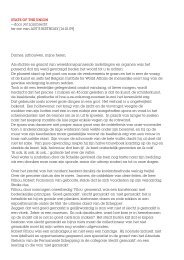
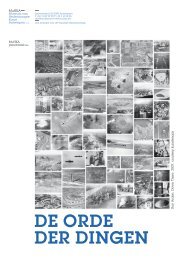
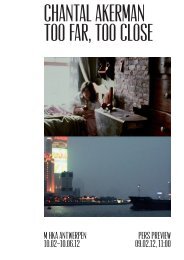
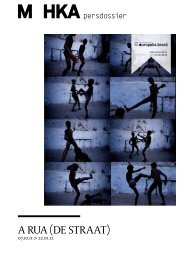
![LE[S] MOI[S] DE LIZÈNE ZA 31.01→VR 27.03.09 - MuHKA](https://img.yumpu.com/19722570/1/186x260/les-mois-de-lizene-za-3101-vr-270309-muhka.jpg?quality=85)

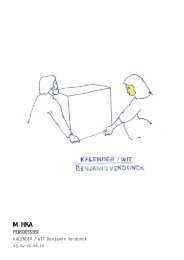
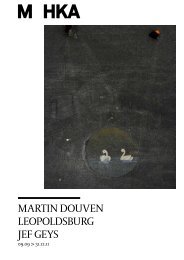
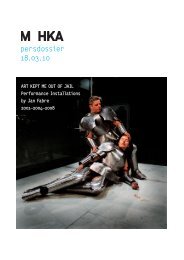
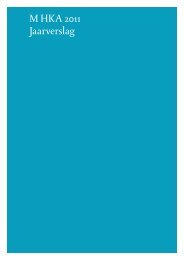
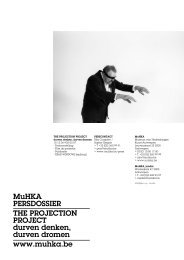
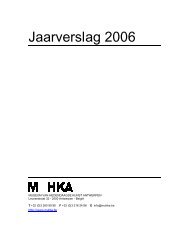
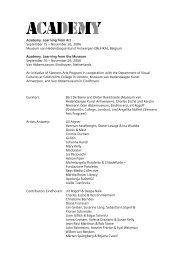
![PERSCONTACT Rita Compère > T +32 [0]3 260 99 91 ... - MuHKA](https://img.yumpu.com/3143280/1/184x260/perscontact-rita-compere-t-32-03-260-99-91-muhka.jpg?quality=85)